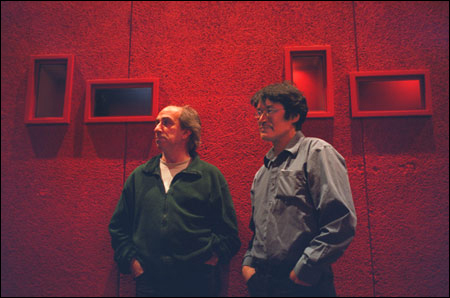Chronicler of loss
HFA honors Inuit filmmaker with the first Sun Hill Award for Excellence

As a youngster attending school in the small Inuit community of Igloolik in Canada’s Northwest Territories, Zacharias Kunuk made and sold carvings to earn money to go to the movies.
At first, the Hollywood productions Kunuk watched were simply an entertaining way to spend a couple of hours. But as he got older it occurred to him that if he could get his hands on a movie camera, he could make movies himself, movies shot from an Inuit point of view.
“I learned that anyone could have a movie camera, so I thought, why shouldn’t I have one?”
With money earned from his carvings, Kunuk purchased a high-quality video camera and brought it back to Igloolik. He had definite notions about what he wanted to shoot.
“I had seen a lot of southern films about our culture, and it was all just props and sets. There were a lot of mistakes. I wanted to do it right.”
Kunuk was at the Harvard Film Archive Feb. 6 and 7 to present some of the films
‘I had seen a lot of southern films about our culture, and it was all just props and sets. There were a lot of mistakes. I wanted to do it right.’
– Zacharias Kunuk
Filmmaker
he has made. On Friday, he showed his award-winning film, “Atanarjuat” or “The Fast Runner,” a feature-length fiction film based on an Inuit legend about an evil shaman who brings about a deadly feud between two families. On Saturday, he showed several documentary films he has made about Inuit life.
Also on hand was Kunuk’s filmmaking partner, Norman Cohn, the only non-Inuit member of Isuma Productions (an Inuit word meaning “think”). Born in Brooklyn, N.Y., Cohn spent many years working as a video artist, coming to Canada in the 1970s to participate in the Canadian Film Board’s program for experimental film and video.
While there, he happened upon some video Kunuk had shot for the Inuit Broadcasting Corp. and recognized a kindred artistic spirit. He and Kunuk have been making films together for the past 17 years.
Saturday evening’s presentation included an episode from the documentary series “Nunavut” (“Our Land”), which portrays Inuit life as it was about 60 years ago.
“The world of 1945 was one of those change moments,” said Cohn. “People were beginning to use things like rifles and kerosene stoves, but it was about 10 years before the government scooped them up into towns. They were still leading a nomadic lifestyle, but change was in the air.”
The film shows a family driving their dogsled over the white, nearly featureless expanse of the tundra, hunting seals and caribou and eating the raw meat, fishing for salmon, building shelters from snow blocks or bricks of frozen sod, and attending a service in a tiny Catholic church.
In this scene, the Inuits listen with puzzled attention as the priest (played by Cohn in a long black robe and bushy beard) tells the story of Moses and the burning bush and the struggle of the Hebrew people to escape from the land of Egypt. At the end of the sermon he admonishes them to “turn away from your old way of life,” and to refrain from hunting or working on the Sabbath.
Later, Cohn explained: “The concept of Sunday was as foreign as anything Christianity introduced. To the Inuit, Sunday would simply mean any day when the sun was shining. Their activities were totally dependent on the weather.”
Another documentary, “Shaman Stories,” presents interviews with members of the Inuit community, many of them elderly, who describe the supernatural forces that once dominated their spiritual worldview. These traditional animist beliefs have nearly vanished from the Inuit community. Cohn said that he is astonished by the speed with which this transformation occurred.
“These people were kings of their own universe. They were totally fearless. They had no fear of death. Now, 75 years later, everyone in Igloolik is Catholic, Anglican, or Pentecostal. Every once in a while, Zach and I look at each other and say, how did this happen?”
The film they are working on now, set in the 1920s when Christianity first began to penetrate the Northwestern Territories, will attempt to answer this very question.




